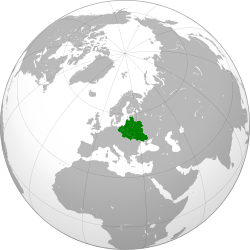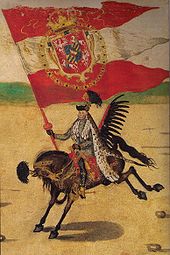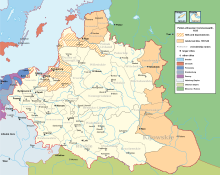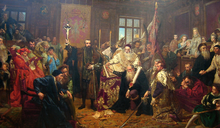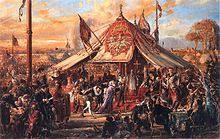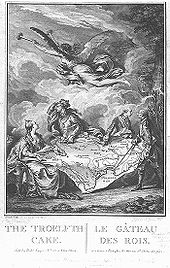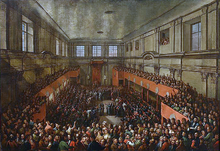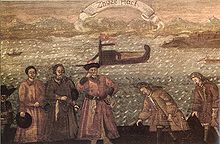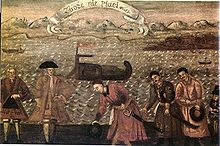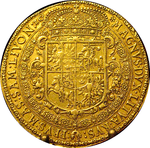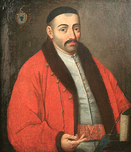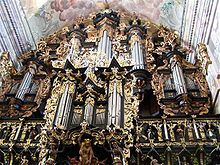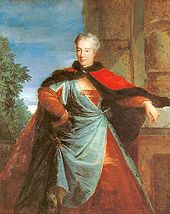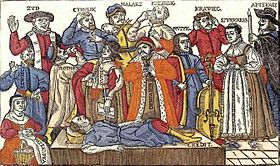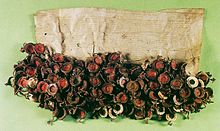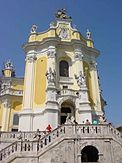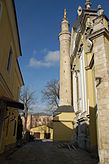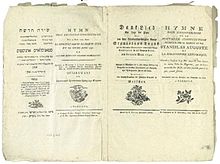
Polish–Lithuanian Commonwealth
Did you know...
The articles in this Schools selection have been arranged by curriculum topic thanks to SOS Children volunteers. SOS Child sponsorship is cool!
| Polish–Lithuanian Commonwealth↓ | ||||||
|
||||||
|
||||||
| Motto Latin: Si Deus nobiscum quis contra nos (If God is with us, then who is against us) Pro Fide, Lege et Rege (Latin: For Faith, Law and King, since 18th century) |
||||||
|
The location of the Polish–Lithuanian Commonwealth at its maximum extent
|
||||||
| Capital | Kraków & Vilnius (1569–1596) Warsaw (1596–1795) |
|||||
| Languages | ||||||
| Religion |
|
|||||
| Government | Hereditary Monarchy (1569–1573) Elective Monarchy (1573–1791 / 1792–1795) Constitutional Monarchy (1791–1792) |
|||||
| King / Grand Duke | ||||||
| - | 1569–1572 | Sigismund II Augustus | ||||
| - | 1764–1795 | Stanisław II Augustus | ||||
| Legislature | General Sejm | |||||
| - | Privy Council | Senate | ||||
| Historical era | Early modern period | |||||
| - | Union established | July 1, 1569 | ||||
| - | fief of the Ottoman Empire | 1672-1676 | ||||
| - | Protectorate of the Russian Empire | 1768 | ||||
| - | May 3rd Constitution | May 3, 1791 | ||||
| - | 2nd Partition | January 23, 1793 | ||||
| - | 3rd Partition | October 24, 1795 | ||||
| Area | ||||||
| - | 1582 | 815,000 km² (314,673 sq mi) | ||||
| - | 1618 | 1,153,465 km² (445,355 sq mi) | ||||
| Population | ||||||
| - | 1582 est. | 6,500,000 | ||||
| Density | 8 /km² (20.7 /sq mi) | |||||
| - | 1618 est. | 10,500,000 | ||||
| Density | 9.1 /km² (23.6 /sq mi) | |||||
| Today part of | ||||||
The Polish–Lithuanian Commonwealth (or Union, after 1791 the Commonwealth of Poland) was a dualistic state of Poland and Lithuania ruled by a common monarch. It was one of the largest and one of the most populous countries of 16th- and 17th-century Europe, with some 1,000,000 square kilometres (390,000 sq mi) and a multi-ethnic population of 11 million at its peak in the early 17th century. It was established at the Union of Lublin in July 1569 and disappeared as an independent state after the Third Partition of Poland in 1795.
The Union possessed features unique among contemporary states. Its political system was characterized by strict checks upon monarchical power. These checks were enacted by a legislature ( Sejm) controlled by the nobility ( szlachta). This idiosyncratic system was a precursor to modern concepts of democracy, constitutional monarchy, and federation. The two component states of the Commonwealth were formally equal, yet Poland was the dominant partner in the union.
The Polish–Lithuanian Commonwealth was marked by high levels of ethnic diversity and by relative religious tolerance, guaranteed by the Warsaw Confederation Act 1573; however, the degree of religious freedom varied over time.
After several decades of prosperity, it entered a period of protracted political, military and economic decline. Its growing weakness led to its partitioning among its more powerful neighbors, Austria, Prussia and the Russian Empire, during the late 18th century. Shortly before its demise, the Commonwealth adopted a massive reform effort and enacted the Constitution of May 3, 1791 - the first written constitution in modern European history and the second in modern world history.
Name
The official name of the Commonwealth was The Kingdom of Poland and the Grand Duchy of Lithuania ( Polish: Królestwo Polskie i Wielkie Księstwo Litewskie, Lithuanian: Lenkijos Karalystė ir Lietuvos Didžioji Kunigaikštystė, Ukrainian: Королівство Польське та Вели́ке кня́зівство Лито́вське Korolivstvo Polśke ta Vełyke Kniazivstvo Łytovśke, Belarusian: Каралеўства Польскае і Вялікае Княства Літоўскае Karalieŭstva Polskaje i Vialikaje Kniastva Litoŭskaje). Prior to the 17th century, international treaties and diplomatic texts referred to it by its Latin name Regnum Poloniae Magnusque Ducatus Lithuaniae. In the 17th century and later it was usually known as the Most Serene Republic of Poland (Polish Najjaśniejsza Rzeczpospolita Polska, Latin Serenissima Res Publica Poloniae). Its inhabitants referred to it in everyday speech as the " Rzeczpospolita" ( Rusyn: Рѣч Посполита Rič Pospolyta, Lithuanian: Žečpospolita). Western Europeans often simply called it Poland, applying the pars pro toto synecdoche. The widespread term 'Commonwealth of Both Nations' (Rzeczpospolita Obojga Narodów) was coined in the 20th century. In historiography commonly referred to as Rzeczpospolita Szlachecka (The Republic of Nobles) or as I Rzeczpospolita (The First (Polish) Republic).
History
Poland and Lithuania underwent an alternating series of wars and alliances during the 14th century and early 15th century. Several relatively weak agreements between the two (the Union of Kraków and Vilna, the Union of Krewo, the Union of Vilnius and Radom, the Union of Grodno, and the Union of Horodło) were struck before the permanent 1569 Union of Lublin. This agreement was one of the signal achievements of Sigismund II Augustus, last monarch of the Jagiellon dynasty. Sigismund believed he could preserve his dynasty by adopting elective monarchy. His death in 1572 was followed by a three-year interregnum during which adjustments were made to the constitutional system; these adjustments significantly increased the power of the Polish nobility and established a truly elective monarchy.
The Commonwealth reached its Golden Age in the early 17th century. Its powerful parliament was dominated by nobles (Pic. 2) who were reluctant to get involved in the Thirty Years' War; this neutrality spared the country from the ravages of a political-religious conflict which devastated most of contemporary Europe. The Commonwealth was able to hold its own against Sweden, Tsardom of Russia, and vassals of the Ottoman Empire, and even launched successful expansionist offensives against its neighbors. In several invasions during the Time of Troubles Commonwealth troops entered Russia and managed to take Moscow and hold it from September 27, 1610 to November 4, 1612, until driven out after a siege.
Commonwealth power began waning after a series of blows during the following decades. A major rebellion of Cossacks in the southeastern portion of the Commonwealth (the Khmelnytskyi Uprising in modern-day Ukraine) began in 1648. It resulted in a Ukrainian request, under the terms of the Treaty of Pereyaslav, for protection by the Muscovian Tsar. Muscovian annexation of part of Ukraine gradually supplanted Polish influence. The other blow to the Commonwealth was a Swedish invasion in 1655, known as the The Deluge, which was supported by troops of Transylvanian duke George II Rákóczi and Elector of Brandenburg Frederick William.
In the late 17th century, the weakened Commonwealth's King John III Sobieski allied himself with Leopold I to deal crushing defeats to the Ottoman Empire. In 1683, the Battle of Vienna marked the final turning point in a 250-year struggle between the forces of Christian Europe and the Islamic Ottoman Empire. For its centuries-long stance against the Muslim advances, the Commonwealth would gain the name of Antemurale Christianitatis (bulwark of Christianity). During the next 16 years the Great Turkish War would drive the Turks permanently south of the Danube River, never to threaten central Europe again.
By the 18th century, destabilization of its political system brought Poland to the brink of civil war. The Commonwealth was facing many internal problems and was vulnerable to foreign influences. An outright war between the King and the nobility broke out in 1715 and Tsar Peter the Great's mediation put him in a position to further weaken the state. The Russian army was present at the Silent Sejm of 1717, which limited the armed forces to 24,000 and specified its funding, reaffirmed the liberum veto, and banished the King's Saxon army; the Tsar was to serve as guarantor of the agreement. Western Europe's increasing exploitation of resources in the Americas rendered the Commonwealth's supplies less crucial. In 1768 the Polish–Lithuanian Commonwealth became a protectorate of the Russian Empire. Control of Poland was central to Catherine the Great's diplomatic and military strategies. Attempts at reform, such as the Four-Year Sejm's May Constitution came too late. The country was partitioned in three stages by the neighboring Russian Empire, Kingdom of Prussia, and the Habsburg Monarchy. By 1795, the Polish–Lithuanian Commonwealth had been completely erased from the map of Europe. Poland and Lithuania would not be re-established as independent countries until 1918.
State organization and politics
Golden Liberty
The political doctrine of the Commonwealth was: our state is a republic under the presidency of the King. Chancellor Jan Zamoyski summed up this doctrine when he said that Rex regnat et non gubernat ("The King reigns but [lit. 'and'] does not govern"). The Commonwealth had a parliament, the Sejm, as well as a Senat and an elected king (Pic. 1). The king was obliged to respect citizens' rights specified in King Henry's Articles as well as in Pacta conventa, negotiated at the time of his election.
The monarch's power was limited, in favour of a sizable noble class. Each new king had to pledge to uphold the Henrician Articles, which were the basis of Poland's political system (and included near-unprecedented guarantees of religious tolerance). Over time, the Henrician Articles were merged with the Pacta Conventa, specific pledges agreed to by the king-elect. From that point onwards, the king was effectively a partner with the noble class and was constantly supervised by a group of senators. The Sejm could veto the king on important matters, including legislation (the adoption of new laws), foreign affairs, declaration of war, and taxation (changes of existing taxes or the levying of new ones).
The foundation of the Commonwealth's political system, the " Golden Liberty" ( Polish: Złota Wolność, a term used from 1573 on), included:
- election of the king by all nobles wishing to participate, known as wolna elekcja (free election);
- Sejm, the Commonwealth parliament which the king was required to hold every two years;
- Pacta conventa (Latin), "agreed-to agreements" negotiated with the king-elect, including a bill of rights, binding on the king, derived from the earlier Henrician Articles.
- religious freedom guaranted by Warsaw Confederation Act 1573,
- rokosz ( insurrection), the right of szlachta to form a legal rebellion against a king who violated their guaranteed freedoms;
- liberum veto (Latin), the right of an individual Sejm deputy to oppose a decision by the majority in a Sejm session; the voicing of such a "free veto" nullified all the legislation that had been passed at that session; during the crisis of the second half of the 17th century, Polish nobles could also use the liberum veto in provincial sejmiks;
- konfederacja (from the Latin confederatio), the right to form an organization to force through a common political aim.
The three regions (see below) of the Commonwealth enjoyed a degree of autonomy. Each voivodship had its own parliament (sejmik), which exercised serious political power, including choice of poseł ( deputy) to the national Sejm and charging of the deputy with specific voting instructions. The Grand Duchy of Lithuania had its own separate army, treasury and most other official institutions.
Golden Liberty created a state that was unusual for its time, although somewhat similar political systems existed in the contemporary city-states like the Republic of Venice. Interestingly, both states were styled "Serenissima Respublica" or the " Most Serene Republic". At a time when most European countries were headed toward centralization, absolute monarchy and religious and dynastic warfare, the Commonwealth experimented with decentralization, confederation and federation, democracy, religious tolerance, and even pacifism. The Sejm's usual veto of wars has been described as an example of democratic peace theory.
This political system unusual for its time stemmed from the ascendance of the szlachta noble class over other social classes and over the political system of monarchy. In time, the szlachta accumulated enough privileges (such as those established by the Nihil novi Act of 1505) that no monarch could hope to break the szlachta's grip on power. The Commonwealth's political system is difficult to fit into a simple category, but it can be tentatively described as a mixture of:
- confederation and federation, with regard to the broad autonomy of its regions. It is, however, difficult to decisively call the Commonwealth either confederation or federation, as it had some qualities of both;
- oligarchy, as only the szlachta—around 15% of the population—had political rights;
- democracy, since all the szlachta were equal in rights and privileges, and the Sejm could veto the king on important matters, including legislation (the adoption of new laws), foreign affairs, declaration of war, and taxation (changes of existing taxes or the levying of new ones). Also, the 15% of Commonwealth population who enjoyed those political rights (the szlachta) was a substantially larger percentage than in majority European countries; note that in 1789 in France only about 1% of the population had the right to vote, and in 1867 in the United Kingdom, only about 3%.
- elective monarchy, since the monarch, elected by the szlachta, was Head of State;
- constitutional monarchy, since the monarch was bound by pacta conventa and other laws, and the szlachta could disobey any king's decrees they deemed illegal.
Shortcomings
The end of the Jagiellon dynasty in 1572—after nearly two centuries—disrupted the fragile equilibrium of the Commonwealth's government. Power increasingly slipped away from the central government to the nobility.
When presented with periodic opportunities to fill the throne, the szlachta exhibited a preference for foreign candidates who would not found another strong dynasty. This policy often produced monarchs who were either totally ineffective or in constant debilitating conflict with the nobility. Furthermore, aside from notable exceptions such as the able Transylvanian Stefan Batory (1576–86), the kings of foreign origin were inclined to subordinate the interests of the Commonwealth to those of their own country and ruling house. This was especially visible in the policies and actions of the first two elected kings from the Swedish House of Vasa, whose politics brought the Commonwealth into conflict with Sweden, culminating in the war known as The Deluge (1655), one of the events that mark the end of the Commonwealth's Golden Age and the beginning of the Commonwealth's decline.
Zebrzydowski's rokosz (1606–07) marked a substantial increase in the power of the Polsih magnates, and the transformation of szlachta democracy into magnate oligarchy. The Commonwealth's political system was vulnerable to outside interference, as Sejm deputies bribed by foreign powers might use their liberum veto to block attempted reforms. This sapped the Commonwealth and plunged it into political paralysis and anarchy for over a century, from the mid-17th century to the end of the 18th, while its neighbors stabilized their internal affairs and increased their military might.
Late reforms
The Commonwealth did eventually make a serious effort to reform its political system, adopting in 1791 the Constitution of May 3, 1791, which historian Norman Davies calls the first of its kind in Europe. The revolutionary Constitution recast the erstwhile Polish–Lithuanian Commonwealth as a Polish–Lithuanian federal state with a hereditary monarchy and abolished many of the deleterious features of the old system. The new constitution:
- abolished the liberum veto and banned the szlachta's confederations;
- provided for a separation of powers among legislative, executive and judicial branches of government;
- established " popular sovereignty" and extended political rights to include not only the nobility but the bourgeoisie;
- increased the rights of the peasantry;
- preserved religious tolerance (but with a condemnation of apostasy from the Catholic faith).
These reforms came too late, however, as the Commonwealth was immediately invaded from all sides by its neighbors which were content to leave the Commonwealth alone as a weak buffer state, but reacted strongly to king Stanisław August Poniatowski's and other reformers' attempts to strengthen the country. Russia feared the revolutionary implications of the May 3rd Constitution's political reforms and the prospect of the Commonwealth regaining its position as a European empire. Catherine the Great regarded the May constitution as fatal to her influence and declared the Polish constitution Jacobinical. Grigori Aleksandrovich Potemkin drafted the act for the Targowica Confederation, referring to the constitution as the "contagion of democratic ideas". Meanwhile, Prussia and Austria, also afraid of a strengthened Poland, used it as a pretext for further territorial expansion. Prussian minister Ewald Friedrich von Hertzberg called the constitution "a blow to the Prussian monarchy", fearing that strengthened Poland would once again dominate Prussia. In the end, the May 3rd Constitution was never fully implemented, and the Commonwealth entirely ceased to exist only four years after the Constitution's adoption.
Economy
The economy of the Commonwealth was dominated by feudal agriculture based on the plantation system ( serfs). Slavery in Poland was forbidden in the 15th century; in Lithuania, slavery was formally abolished in 1588. They were replaced by the second enserfment. Typically a nobleman's landholding comprised a folwark, a large farm worked by serfs to produce surpluses for internal and external trade. This economic arrangement worked well for the ruling classes in the early era of the Commonwealth, which was one of the most prosperous eras of the grain trade. The economic strength of Commonwealth grain trade waned from the late 17th century on. Trade relationships were disrupted by the wars and the Commonwealth proved unable to improve its transport infrastructure or its agricultural practices. Serfs in the region were increasingly tempted to flee. The Commonwealth's major attempts at countering this problem and improving productivity consisted of increasing serfs' workload and further restricting their freedoms in a process known as export-led serfdom.
Though the urban population of the Commonwealth was about 20% of the total in the 17th century, which was much lower than in some West European countries (approximately 50% in the Netherlands and Italy) the urbanization of the country was of a specific character (Pic. 7). The Commonwealth's preoccupation with agriculture, coupled with the szlachta's privileged position when compared to the bourgeoisie, resulted in a fairly slow process of urbanization and thus a rather slow development of industries. While similar conflicts among social classes may be found all over Europe, nowhere were the nobility as dominant at the time as in the Polish–Lithuanian Commonwealth. There is, however, much debate among historians as to which processes most affected those developments, since until the wars and crises of the mid-17th century the cities of the Commonwealth had not markedly lagged in size and wealth behind their western counterparts. The Commonwealth did have numerous towns and cities, commonly founded on Magdeburg rights. Some of the largest trade fairs in the Commonwealth were held at Lublin. See the geography section, below, for a list of major cities in the Commonwealth (commonly capitals of voivodships).
Poland-Lithuania played a significant role in the supply of 16th century Western Europe by the export of three sorts of goods, notably grain (rye), cattle (oxen) and fur. These three articles amounted to nearly 90% of the country's exports to western markets by overland- and maritime trade.
Although the Commonwealth was Europe's largest grain producer, the bulk of her grain was consumed domestically. Estimated grain consumption in the Polish Crown (Poland proper) and Prussia in 1560–70 was some 113,000 tons of wheat (or 226,000 łaszt – a łaszt, or "last", being a large bulk measure; in the case of grain, about half a ton). Average yearly production of grain in the Commonwealth in the 16th Century was 120,000 tons, 6% of which was exported, while cities consumed some 19% and the remainder was consumed by the villages. Commonwealth grain achieved far more importance in poor crop years, as in the early 1590s and the 1620s, when governments throughout southern Europe arranged for large grain imports to cover shortfalls in their jurisdictions.
Still, grain was the largest export commodity of the Commonwealth. The owner of a folwark usually signed a contract with merchants of Gdańsk, who controlled 80% of this inland trade, to ship the grain north to that seaport on the Baltic Sea. Many rivers in the Commonwealth were used for shipping purposes: the Vistula, Pilica, Bug, San, Nida, Wieprz, Neman. The rivers had relatively developed infrastructure, with river ports and granaries. Most of the river shipping moved north, southward transport being less profitable, and barges and rafts were often sold off in Gdańsk for lumber. Hrodna become an important site after formation of a customs post at Augustów in 1569, which became a checkpoint for merchants travelling to the Crown lands from the Grand Duchy.
From Gdańsk, ships, mostly from the Netherlands and Flanders, carried the grain to ports such as Antwerp and Amsterdam. Besides grain, other seaborne exports included carminic acid from Polish cochineal, lumber and wood-related products such as ash, and tar. The land routes, mostly to the German lands of the Holy Roman Empire such as the cities of Leipzig and Nuremberg, were used for export of live cattle (herds of around 50,000 head) hides, furs, salt, tobacco, hemp, cotton (mostly from Greater Poland) and linen.
The Commonwealth imported wine, fruit, spices, luxury goods (e.g. tapestries, Pic. 5), clothing, fish, beer and industrial products like steel and tools. A few riverboats carried south imports from Gdańsk like wine, fruit, spices and herring. Somewhere between the 16th and 17th centuries, the Commonwealth's trade balance shifted from positive to negative.
With the advent of the Age of Discovery, many old trading routes such as the Amber Road (Pic. 4) lost importance as new ones were created. Poland's importance as a caravan route between Asia and Europe diminished, while new local trading routes were created between the Commonwealth and Russia. Many goods and cultural artifacts continued to pass from one region to another via the Commonwealth. For example, Isfahan rugs imported from Persia to the Commonwealth were actually known in the West as "Polish rugs" (French: Polonaise).
Commonwealth currency included the złoty and the grosz. The City of Gdańsk had the privilege of minting its own coinage.
Culture
Science and literature
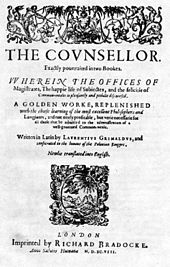
The Commonwealth was an important European centre for the development of modern social and political ideas. It was famous for its rare quasi-democratic political system, praised by philosophers such as Erasmus; and, during the Counter-Reformation, was known for near-unparalleled religious tolerance, with peacefully coexisting Catholic, Jewish, Eastern Orthodox, Protestant and Muslim communities. In the 18th century, the French Catholic Rulhiere wrote of 16th century Poland: "This country, which in our day we have seen divided on the pretext of religion, is the first state in Europe that exemplified tolerance. In this state, mosques arose between churches and synagogues.” The Commonwealth gave rise to the famous Christian sect of the Polish Brethren, antecedents of British and American Unitarianism.
With its political system, the Commonwealth gave birth to political philosophers such as Andrzej Frycz Modrzewski (1503–1572) (Pic. 9), Wawrzyniec Grzymała Goślicki (1530–1607) and Piotr Skarga (1536–1612). Later, works by Stanisław Staszic (1755–1826) and Hugo Kołłątaj (1750–1812) helped pave the way for the Constitution of May 3, 1791, which Norman Davies calls the first of its kind in Europe.
Kraków's Jagiellonian University is one of the oldest universities in the world (established in 1364), together with the Vilnius University (established in 1579) they were the major scholarly and scientific centers in the Commonwealth. The Komisja Edukacji Narodowej, Polish for Commission for National Education, formed in 1773, was the world's first national Ministry of Education. Commonwealth scientists included: Martin Kromer (1512–1589), historian and cartographer; Michał Sędziwój (1566–1636), alchemist and chemist; Jan Brożek (Ioannes Broscius in Latin) (1585–1652), polymath: a mathematician, physician and astronomer; Krzysztof Arciszewski (Crestofle d'Artischau Arciszewski in Portuguese) (1592–1656), engineer, ethnographer, general and admiral of the Dutch West Indies Company army in the war with the Spanish Empire for control of Brazil; Kazimierz Siemienowicz (1600–1651), military engineer, artillery specialist and a founder of rocketry; Johannes Hevelius (1611–1687), astronomer, founder of lunar topography; Michał Boym (1612–1659), orientalist, cartographer, naturalist and diplomat in Ming Dynasty's service (Pic. 11); Adam Adamandy Kochański (1631–1700), mathematician and engineer; Baal Shem Tov (הבעל שם טוב in Hebrew) (1698–1760), considered to be the founder of Hasidic Judaism; Marcin Odlanicki Poczobutt (1728–1810), astronomer and mathematician (Pic. 12); Jan Krzysztof Kluk (1739–1796), naturalist, agronomist and entomologist, John Jonston (1603–1675) scholar and physician, descended from Scottish nobility. In 1628 the Czech teacher, scientist, educator, and writer John Amos Comenius took refuge in the Commonwealth, when the Protestants were persecuted under the Counter Reformation.
The works of many Commonwealth authors are considered classics, including those of Jan Kochanowski (Pic. 10), Wacław Potocki, Ignacy Krasicki, and Julian Ursyn Niemcewicz. Many szlachta members wrote memoirs and diaries. Perhaps the most famous are the Memoirs of Polish History by Albrycht Stanisław Radziwiłł (1595–1656) and the Memoirs of Jan Chryzostom Pasek (ca. 1636–ca. 1701). Jakub Sobieski (1590–1646) (father of John III Sobieski) wrote notable diaries. During the Khotyn expedition in 1621 he wrote a diary called Commentariorum chotinensis belli libri tres (Diary of the Chocim War), which was published in 1646 in Gdańsk. It was used by Wacław Potocki as a basis for his epic poem, Transakcja wojny chocimskiej (The Progress of the War of Chocim). He also authored instructions for the journey of his sons to Kraków (1640) and France (1645), a good example of liberal education of the era.
Art and music
The two great religious cultures of the Commonwealth, Latin and Eastern Orthodox, coexisted and penetrated each other, which is reflected in the great popularity of icons (Pic. 13) and the icons resembling effigies of Mary, as well as the metal dresses typical of the Orthodox Church in the predominantly Latin territories of today's Poland ( Black Madonna) and Lithuania ( Our Lady of the Gate of Dawn). The implementation of post-Renaissance naturalism and the sentimentality of the Polish baroque in Orthodox painting as well as the creation of the Cossack Baroque style in architecture, also inspired by Polish patterns, were the major factors of Latin infiltration into Eastern Orthodox art (Pic. 3).
A common art form of the Sarmatian period were coffin portraits, particular to the culture of the Commonwealth, used in funerals and other important ceremonies. As a rule, such portraits were nailed to sheet metal, six – or eight – sided in shape, fixed to the front of a coffin placed on a high, ornate catafalque.
Another characteristic is common usage of black marble. Altars, fonts, portals, balustrades, columns, monuments, tombstones, headstones and whole rooms (e.g. Marble Room at the Royal Castle in Warsaw, St. Casimir Chapel of the Vilnius Cathedral and Vasa Chapel of the Wawel Cathedral) were decorated with black marble.
Music was a common feature of religious and secular events. To that end many noblemen founded church and school choirs, and employed their own ensembles of musicians. Some, like Stanisław Lubomirski build their own opera houses (in Nowy Wiśnicz). Yet others, like Janusz Skumin Tyszkiewicz and Krzysztof Radziwiłł were known for their sponsorship of arts which manifested itself in their permanently retained orchestras, at their courts in Vilnius. Musical life further flourished during the reign of the Vasas. Both foreign and domestic composers were active in the Commonwealth. King Sigismund III brought in Italian composers and conductors, such as Luca Marenzio, Annibale Stabile, Asprilio Pacelli, Marco Scacchi and Diomedes Cato for the royal orchestra. Notable home grown musicians, who also composed and played for the King's court, included Bartłomiej Pękiel, Jacek Różycki, Adam Jarzębski, Marcin Mielczewski, Stanisław Sylwester Szarzyński, Damian Stachowicz, Mikołaj Zieleński and Grzegorz Gorczycki.
Magnates often undertook construction projects as monuments to themselves: churches, cathedrals, monasteries (Pic. 14), and palaces like the present-day Presidential Palace in Warsaw and Pidhirtsi Castle built by Grand Hetman Stanisław Koniecpolski herbu Pobóg. The largest projects involved entire towns, although in time many of them would lapse into obscurity or be totally abandoned. Usually they were named after the sponsoring magnate. Among the most famous is the town of Zamość, founded by Jan Zamoyski and designed by the Italian architect Bernardo Morando. The magnates throughout Poland competed with the kings. The monumental castle Krzyżtopór, built in the style palazzo in fortezza between 1627 and 1644, had several courtyards surrounded by fortifications. Due to efforts of powerful Radziwiłł family, the town of Nesvizh in today's Belarus came to exercise significant influence in many domains – the Nesvizh manufactures of firearm, carpets, kontusz sashes and tapestries as well as school of painting produced renowned and luxury items. Late baroque fascination with the culture and art of the "central nation" is reflected in Queen Masysieńka's Chinese Palace in Zolochiv. 18th century magnate palaces represents the characteristic type of baroque suburban residence built entre cour et jardin (between the entrance court and the garden). Its architecture - a merger of European art with old Commonwealth building traditions are visible in Wilanów Palace in Warsaw (Pic. 15), Branicki Palace in Białystok and in Warsaw, Potocki Palace in Radzyń Podlaski and in Krystynopol, Raczyński Palace in Rogalin and Sapieha Palace in Ruzhany.
Szlachta and Sarmatism
The prevalent ideology of the szlachta became " Sarmatism", named after the Sarmatians, alleged ancestors of the Poles. This belief system was an important part of the szlachta's culture, penetrating all aspects of its life. Sarmatism enshrined equality among szlachta, horseback riding, tradition, provincial rural life, peace and pacifism; championed oriental-inspired attire ( żupan, kontusz, sukmana, pas kontuszowy, delia, szabla); and served to integrate the multi-ethnic nobility by creating an almost nationalistic sense of unity and of pride in the szlachta's Golden Freedoms.
In its early, idealistic form, Sarmatism represented a positive cultural movement: it supported religious belief, honesty, national pride, courage, equality and freedom. In time, however, it became distorted. Late extreme Sarmatism turned belief into bigotry, honesty into political naïveté, pride into arrogance, courage into stubbornness and freedom into anarchy. The faults of Sarmatism were blamed for the demise of the country from the late 18th century onwards. Criticism, often one-sided and exaggerated, was used by the Polish reformists to push for radical changes. This self-deprecation was accompanied by works of Prussian, Russian and Austrian historians, who tried to prove that it was Poland itself that was to blame for its fall.
Demographics and religion
The population of the Commonwealth was never overwhelmingly either Roman Catholic or Polish. This circumstance resulted from Poland's possession of Ukraine and confederation with Lithuania, in both of which countries ethnic Poles were a distinct minority. The Commonwealth comprised primarily four nations: Lithuanians, Poles, Belarusians and Ukrainians; the latter two usually referred to as the Ruthenians. Sometimes inhabitants of the Grand Duchy of Lithuania were called Litvins, a Slavic term for people from Lithuania, regardless their ethnicity (with the exception of Jews, which were called Litvaks). Shortly after the Union of Lublin ( 1569 ), the Commonwealth population was around 7 million, with a rough breakdown of 4.5 m Poles, 0.75 m Lithuanians, 0.7 m/10% Jews and 2 m Ruthenians. In 1618, after the Truce of Deulino, the Commonwealth population increased together with its territory, reaching 11.5 million people, which was composed roughly of 4.5 m Poles, 3.5 m Ukrainians, 1.5 m Belarusians, 0.75 m Lithuanians, 0.75 m Old Prussians, 0.5 m Jews, and 0.5 m Livonians. At that time nobility was 10% of the population, and burghers were 15%. The average population density per square kilometer was: 24 in Mazovia, 23 in Little Poland, 19 in Great Poland, 12 in Lublin palatinate, 10 in the Lvov area, 7 in Podolia and Volhynia, 3 in the Ukraine. There was a tendency for the people from the more densely inhabited western territories to migrate eastwards. In the period from 1648–57, populations losses are estimated at 4 m. Coupled with further population and territorial losses, in 1717 the Commonwealth population had fallen to 9 m, with roughly 4.5 m/50% Poles, 1.5 m/17% Ukrainians, 1.2 m Belarusians, 0.8 m Lithuanians, 0.5 m Jews, and 0.5 m others.
“Certainly, the wording and substance of the declaration of the Confederation of Warsaw of 28 January 1573 were extraordinary with regards to prevailing conditions elsewhere in Europe; and they governed the principles of religious life in the Republic for over two hundred years.” - Norman Davies
Poland has a long tradition of religious freedom. The right to worship freely was a basic right given to all inhabitants of the Commonwealth throughout the 15th and early 16th century, however, complete freedom of religion was officially recognized in Poland in 1573 during the Warsaw Confederation. Poland kept religious freedom laws during an era when religious persecution was an everyday occurrence in the rest of Europe. Commonwealth was a place were the most radical religious sects, trying to escape persecution in other countries of the Christian world, sought refuge. In 1561 Bonifacio d’Oria, a religious exile living in Poland, wrote of his adopted country’s virtues to a colleague back in Italy: “You could live here in accordance with your ideas and preferences, in great, even the greatest freedoms, including writing and publishing. No one is a censor here."
"This country became a place of shelter for heretics” - Cardinal Hozjusz papal legate to Poland.
To be Polish, in the non-Polish lands of the Commonwealth, was then much less an index of ethnicity than of religion and rank; it was a designation largely reserved for the landed noble class (szlachta), which included Poles but also many members of non-Polish origin who converted to Catholicism in increasing numbers with each following generation. For the non-Polish noble such conversion meant a final step of Polonization that followed the adoption of the Polish language and culture. Poland, as the culturally most advanced part of the Commonwealth, with the royal court, the capital, the largest cities, the second-oldest university in Central Europe (after Prague), and the more liberal and democratic social institutions had proven an irresistible magnet for the non-Polish nobility in the Commonwealth. Many referred to themselves as "gente Ruthenus, natione Polonus" (Ruthenian by blood, Polish by nationality) since 16th century onwards.
As a result, in the eastern territories a Polish (or Polonized) aristocracy dominated a peasantry whose great majority was neither Polish nor Roman Catholic. Moreover, the decades of peace brought huge colonization efforts to Ukraine, heightening the tensions among nobles, Jews, Cossacks (traditionally Orthodox), Polish and Ruthenian peasants. The latter, deprived of their native protectors among the Ruthenian nobility, turned for protection to cossacks that facilitated violence that in the end broke the Commonwealth. The tensions were aggravated by conflicts between Eastern Orthodoxy and the Greek Catholic Church following the Union of Brest, overall discrimination of Orthodox religions by dominant Catholicism, and several Cossack uprisings. In the west and north, many cities had sizable German minorities, often belonging to Reformed churches. The Commonwealth had also one of the largest Jewish diasporas in the world – by the mid-16th century 80% of the world's Jews lived in Poland (Pic. 16).
Until the Reformation, the szlachta were mostly Catholic or Eastern Orthodox (Pic. 3, 13). However, many families quickly adopted the Reformed religion. After the Counter-Reformation, when the Roman Catholic Church regained power in Poland, the szlachta became almost exclusively Roman Catholic, despite the fact that Roman Catholicism was not a majority religion (the Roman Catholic and Orthodox churches counted approximately 40% of the population each, while the remaining 20% were Jews and members of various Protestant churches).
The Crown had about double the population of Lithuania and five times the income of the latter's treasury. As with other countries, the borders, area and population of the Commonwealth varied over time. After the Peace of Jam Zapolski (1582), the Commonwealth had approximately 815,000 km² area and a population of 7.5 million. After the Truce of Deulino (1618), the Commonwealth had an area of some 990,000 km² and a population of 10–11 million (including some 4 million Poles and close to a million Lithuanians).
Languages
- Polish - officially recognized; dominant language, used by most of the Commonwealth's nobility and by the peasantry in the Crown province; official language in the Crown chancellery and since 1697 in the Grand Duchy chancellery. Dominant language in the towns.
- Latin - off. recog.; commonly used in foreign relations and popular as a second language among some of the nobility.
- French - not officially recognized; replaced Latin at the royal court in Warsaw in the beginning of the 18th century as a language used in foreign relations and as genuine spoken language. It was commonly used as a language of science and literature and as a second language among some of the nobility.
- Chancellery Ruthenian - also known as Chancellery Slavonic; off. recog.; official language in the Grand Duchy chancellery until 1697 (when replaced by Polish); used in some foreign relations its dialects were widely used in the Grand Duchy and eastern parts of the Crown as spoken language.
- Lithuanian - not officially recognised; but used in some official documents in the Grand Duchy and, mostly, used as a spoken language in the northwest part of the Grand Duchy (in Lithuania Proper) and the northern part of Royal Prussia (Polish Prussia).
- German - off. recog.; used in some foreign relations, in Polish Prussia and by minorities in cities.
- Hebrew - off. recog.; used by the Jews in their religious matters;
- Yiddish, used by the Jews in their daily life but not recognized as an official language.
- Italian - not officially recognised; used in some foreign relations and by Italian minorities in cities.
- Armenian - off. recog. used by the Armenian minority.
- Arabic - not officially recognised; used in some foreign relations and by Tatars in their religious matters, they also wrote Ruthenian in the Arabic script.
Legacy
The Duchy of Warsaw, established in 1807, traced its origins to the Commonwealth. Other revival movements appeared during the November Uprising (1830–31), the January Uprising (1863–64) and in the 1920s, with Józef Piłsudski's failed attempt to create a Polish-led Międzymorze ("Between-Seas") federation that would have included Lithuania and Ukraine. Today's Republic of Poland considers itself a successor to the Commonwealth, whereas the Republic of Lithuania, re-established at the end of World War I, saw the participation of the Lithuanian state in the old Polish–Lithuanian Commonwealth mostly in a negative light at the early stages of regaining its independence, although this attitude has been changing recently.
Administrative division
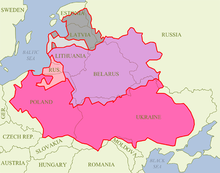
While the term "Poland" was also commonly used to denote this whole polity, Poland was in fact only part of a greater whole—the Polish–Lithuanian Commonwealth, which comprised primarily two parts:
- the Crown of the Polish Kingdom (Poland proper), colloquially "the Crown"; and
- the Grand Duchy of Lithuania, colloquially "Lithuania".
The Commonwealth was further divided into smaller administrative units known as voivodships (województwa). Each voivodship was governed by a voivod (wojewoda, governor). Voivodships were further divided into starostwa, each starostwo being governed by a starosta. Cities were governed by castellans. There were frequent exceptions to these rules, often involving the ziemia subunit of administration.
The lands that once belonged to the Commonwealth are now largely distributed among several Central and East European countries: Poland, Ukraine, Moldova (Transnistria), Belarus, Russia, Lithuania, Latvia, and Estonia. Also some small towns in Slovakia, then within the Kingdom of Hungary, became a part of Poland in the Treaty of Lubowla.
Other notable parts of the Commonwealth, without respect to region or voivodship divisions, include:
- Lesser Poland ( Polish: Małopolska), southern Poland, with two biggest cities, its capital at Kraków (Cracow) and Lublin in the north-east;
- Greater Poland ( Polish: Wielkopolska), west–central Poland around Poznań and the Warta River system;
- Masovia ( Polish: Mazowsze), central Poland, with its capital at Warszawa (Warsaw);
- Lithuania Proper ( Lithuanian: Lietuva siaurąją prasme, tikroji Lietuva), the catholic, or, perhaps, in some cases ethnically Lithuanian, part of Grand Duchy in the northwest of it;
- Samogitia ( Polish: Żmudź, Lithuanian: Žemaitija), an autonomous area of Grand Duchy of Lithuania in the westernmost part of it, the western part of Lithuania Proper;
- Royal Prussia ( Polish: Prusy Królewskie), at the southern shore of the Baltic Sea, was an autonomous area since the Second Peace of Thorn (1466), incorporated into the Crown in 1569 with the Commonwealth's formation;
- Pomerelia ( Polish: Pomorze Gdańskie), Pomerania around Gdańsk (Danzig), western part of Royal Prussia;
- Ruthenia ( Polish: Ruś), the eastern Commonwealth, adjoining Russia;
- Duchy of Livonia (Inflanty), a joint domain of the Crown and the Grand Duchy of Lithuania. Parts lost to Sweden in the 1620s and in 1660;
- Duchy of Courland ( Polish: Kurlandia), a northern fief of the Commonwealth. It established a colony in Tobago in 1637 and on St. Andrews Island at the Gambia River in 1651 (see Couronian colonization);
- Silesia ( Polish: Śląsk) was not within the Commonwealth, but small parts belonged to various Commonwealth kings; in particular, the Vasa kings were dukes of Opole (Oppeln) and Racibórz (Ratibor) from 1645 to 1666.
Commonwealth borders shifted with wars and treaties, sometimes several times in a decade, especially in the eastern and southern parts. After the Peace of Jam Zapolski (1582), the Commonwealth had approximately 815,000 km² area and a population of 7.5 million. After the Truce of Deulino (1618), the Commonwealth had an area of some 1 million km² (990,000 km²) and a population of about 11 million.
Geography
In the 16th century, the Polish bishop and cartographer Martin Kromer published a Latin atlas, entitled Poland: about Its Location, People, Culture, Offices and the Polish Commonwealth, which was regarded as the most comprehensive guide to the country.
Kromer's works and other contemporary maps, such as those of Gerardus Mercator, show the Commonwealth as mostly plains. The Commonwealth's southeastern part, the Kresy, was famous for its steppes. The Carpathian Mountains formed part of the southern border, with the Tatra Mountain chain the highest, and the Baltic Sea formed the Commonwealth's northern border. As with most European countries at the time, the Commonwealth had extensive forest cover, especially in the east. Today, what remains of the Białowieża Forest constitutes the last largely intact primeval forest in Europe.


